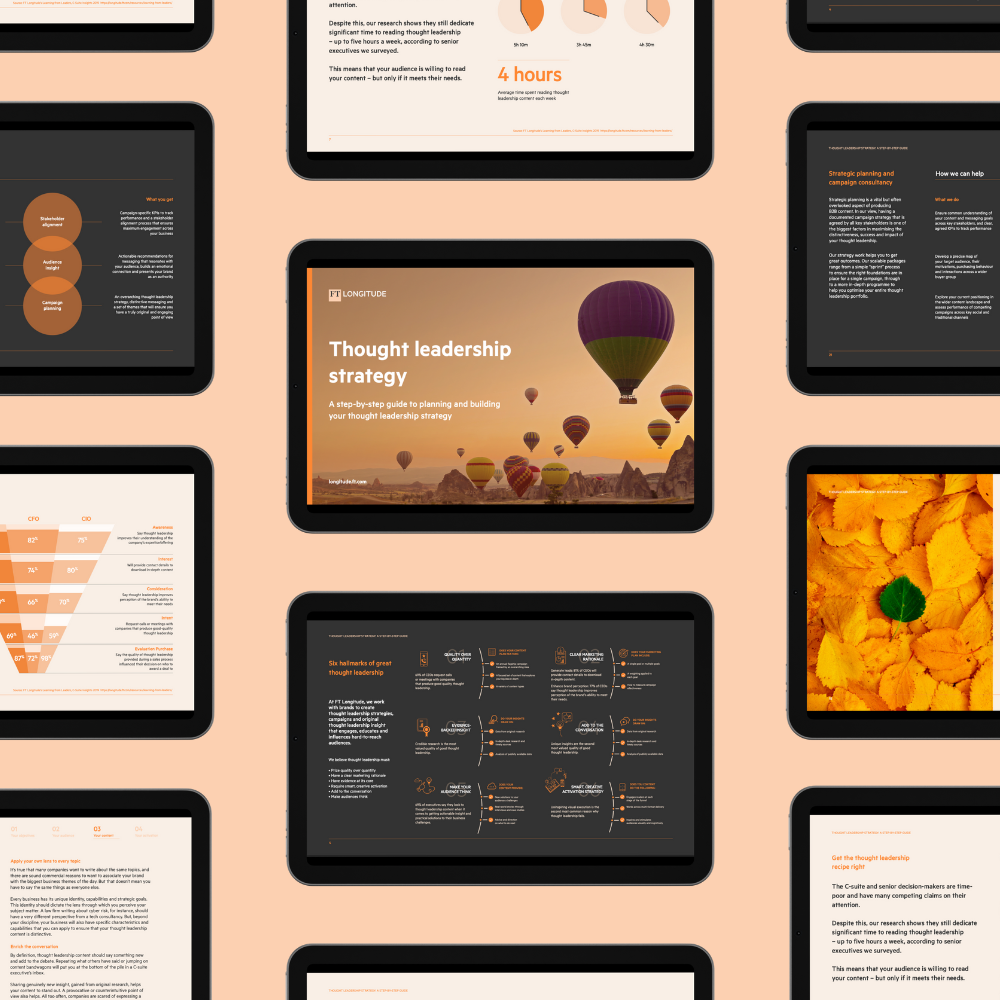Thought leadership strategy
A step-by-step guide to planning and building your thought leadership strategy
Starting with the basics, we explain what thought leadership is and how it can help your business. Then, we share practical advice that you can apply throughout the planning and creation process.
This definitive guide is your go-to resource for step-by-step direction on how to plan, develop and execute a thought leadership strategy.

Download the ebook
Could thought leadership help your brand to rise above the competition?
Whether you’re new to thought leadership or an experienced practitioner, this definitive guide is your go-to resource for step-by-step direction on how to plan, develop and execute a thought leadership strategy.
Starting with the basics, we explain what thought leadership is and how it can help, and then share practical advice that you can apply throughout the planning and creation process.
Download nowWhat is thought leadership?
While thought leadership means different things to different people, the reality is that much of the content that describes itself as “thought leadership” falls wide of every mark.
In its purest form, thought leadership consists of genuine insight that cuts through the clutter and has a real, lasting impact on its audience. Content that fails to connect with people, by definition, cannot be classed as thought leadership.
Thought leadership is original thinking that helps brands to engage top decision-makers and support their broader commercial and marketing goals.
Rob Mitchell, CEO of FT Longitude, defines the commonly misunderstood term of thought leadership and explains a few of the hallmarks of great thought leadership.

6 hallmarks of great thought leadership
At FT Longitude, we work with brands to create thought leadership strategies, campaigns and original B2B content that engages, educates and influences hard-to-reach audiences.
We believe thought leadership should deliver against the following criteria:
Prize quality over quantity.
Have a clear marketing rationale.
Have evidence at its core.
Require smart, creative activation.
Add to the conversation.
Make audiences think.
Download our infographic to see all six hallmarks in one place. In addition, we’ve also included an actionable checklist to ensure you’re on the right track to great thought leadership.
Download nowMaking the case: How can thought leadership help my brand?
Is your company famous in its industry as a source of innovative ideas and thinking? Does it have unusual depth of insight and expertise on the issues that are reshaping the global economy? Can it deliver that knowledge to its customers in a way that is compelling and actionable? And can this delivery reinforce your brand as the go-to provider of solutions to today’s biggest business problems?
This is what it means to be a thought leader.
In each industry, there are a handful of companies that customers automatically look to for new perspectives and expert advice on the challenges they face. As a result, by publishing fresh research and insights into the topics their customers care about, these organisations build up their reputations as leaders in their sectors. Importantly, this strengthens their brands and leads to positive commercial outcomes for their businesses. For example, through stronger pricing power, better customer retention and more rapid client acquisition.
For thought leadership to be successful, it needs to truly engage and inspire your audience.
Learning from leaders
Important research on consumers of thought leadership
The challenge of engaging and influencing business audiences is getting harder and more and more complex.
So how do you market to this elusive audience? Our exclusive Learning from Leaders report shows the value of thought leadership content to senior business leaders, and how that engagement can benefit your brand.
Learn moreLearning from the leaders who read your content
The benefits of thought leadership content are clear. Furthermore, our Learning from Leaders data shows that, when customers see your company as a thought leader, they are much more likely to:
- Show a preference for your brand over your competitors in all engagements;
- Be willing to meet and engage in dialogue with representatives from your company;
- Automatically consider your company when it comes to selecting a partner for a business opportunity.
These days, it is not enough to publish a few white papers and hope that this establishes your business’s intellectual brand.
In fact, to leverage the benefits of thought leadership content, organisations need a sustained strategy, focusing on topics where they have something fresh and compelling to say, and building campaigns that truly engage and inspire their audience.
This is an organisation-wide activity that requires input from multiple functions and specialists – from board-level downwards.
Emma Wheeler, former consultant at Clyde & Co and currently responsible for driving female client strategy for UBS Global Wealth Management, shares what thought leadership means to her, and what it means to run a B2B content programme.
Building a thought leadership strategy
Getting the thought leadership recipe right
Members of the C-suite and other senior decision-makers are typically time-poor and have many competing claims on their attention. Despite this, our Learning from Leaders research shows they still dedicate significant time to reading thought leadership content. In fact, they spend up to five hours a week doing so, according to a cohort of 1,000 senior executives we surveyed. As a result, your audience is willing to read your content – but only if it meets their needs.
This research, as well as our practical experience of working with over 50 global brands, tells us that three things really matter if you’re trying to engage an executive audience. Namely: interesting data, great storytelling and design that brings your ideas to life.
Why strong data is essential
Business audiences are looking for data that gives them new perspectives on the environments in which they operate. When business executives search for interesting content, they’re primarily looking for unique insights, backed by credible research. That is, a nugget of information that provides actionable insight and business value. This is also the component that helps your work pass the credibility test with executives. In other words, you have the evidence to back up what you’re trying to say.
Why great storytelling matters
Skillful storytelling makes sense of the data and answers the “so what?” question in relation to your thought leadership. A logical and compelling structure helps transform abstract concepts into something that resonates with your audience. A good story will also bring coherence to even the most complex topics. Turning good ideas and insights into something that can be absorbed and acted on. Data on its own is just noise without narrative – and weak storytelling is why many thought leadership strategies fail.
Why intelligent and engaging design is critical
Great information design is sorely lacking in a lot of B2B content. Consequently, the vast majority of branded corporate content looks dull and unimaginative. This is not just an issue of aesthetics, although, of course, it’s important to make your work visually appealing. Ultimately, it’s about visual storytelling: finding the most impactful and efficient way to communicate your message, rather than simply distracting the audience with flashy imagery.
So the best thought leadership strategies apply design thinking to the whole audience experience, enticing the reader and making it easier for them to understand and absorb your ideas. Great design is what brings your data and stories to life in a way that’s provocative and engaging. Read more about successfully combining data, storytelling and design here.
From strategy to planning: where do I start?
While clearly a crucial part of developing a thought leadership strategy, the selection of themes and topics is only one step in the planning process. And, in our view, it is a mistake to start thinking about themes before you have answered a few key questions.
We often encourage our clients to think of this as a straightforward ‘Why?’, ‘Who?’, ‘What?’ and ‘How?’ exercise:
1. Why? – think about your marketing objectives. Which outcomes are you hoping to achieve? How will you know if your thought leadership strategy has been successful? Which metrics and KPIs can you track to ensure that your project is meeting its goals?
2. Who? – once you have your objectives, you can target your audience. Who are the decision-makers I want to read my content and influence?
3. What? – only now should you start to discuss topics and themes. Which topics do my audience want to read about? What do I want my company to be associated with?
4. How – finally, you should think about activation. How does my audience consume content? Which platforms resonate the most with my audience and how should I allocate budget across channels?
We go into more detail about the why, who, what and how of thought leadership in a past blog post, and click here to explore our thought leadership offering.
1. Matching thought leadership strategy with your commercial objectives
When planning your thought leadership strategy, the first question you must ask yourself is: which outcomes am I hoping to achieve? Many companies have multiple commercial objectives for their thought leadership and often marketers are expected to deliver on a combination of these.
The overall strategy consists of several campaigns and, on top of this, B2B content often needs to satisfy a diverse range of internal stakeholders, adding a further layer of complexity. Find out more about the advantages of early stakeholder engagement in this past article. Firstly, consider the following objectives that thought leadership can help you achieve, and then highlight your priorities:
- Enhance a brand’s profile and reputation
- Align your organisation with an emerging business theme
- Support lead and revenue generation
- Retain customers and build loyalty
- Deliver press and media coverage
- Be an effective conversation starter for sales
- Serve as the key input and rationale for an event
Your objectives will inform and influence your thought leadership planning process (the audience, the topics and your activation), and will affect how your campaign is structured.
It’s vital to be able to track performance against these metrics. This can be complex, as there are so many different possible KPIs to choose from. However, the golden rule is to worry less about the immediate, activity-based metrics (downloads, page visits, press coverage and so on) and to focus instead on genuine business impact: number of sales meetings, customer loyalty, brand awareness and other, more meaningful metrics.
Case and point
For example, a ‘state of the industry’ report, such as DNV Energy Insdustry Insights, which uses year-on-year research to provide valuable industry insights, is likely to play more to your brand’s profile and reputation. In contrast, a research programme that utilises an online benchmarking tool, such as law firm Simmons & Simmons’ Big Data Race campaign, is very effective at capturing new leads for the business and supporting revenue generation. Bear in mind, however, that these objectives are rarely mutually exclusive. Brand-focused projects can reinforce commercial goals, just as commercially focused projects can reinforce the brand.
2. How to target the right audience with your thought leadership
When thinking about the target audience for your thought leadership, it is important to bear in mind that big purchasing decisions within large corporations are typically made across a leadership team. As such, B2B content campaigns need to speak to each of these different stakeholders as individuals. What matters to a CEO will be different from what matters to a CTO or a CFO. Thought leadership geared to the C-suite must take these different perspectives into account, often with separate, targeted messaging. This is an essential part of planning your campaign.
It’s important to recognise the role that these different individuals play in a purchasing decision. In many cases, the C-suite will influence the selection of suppliers, but they are very rarely the buyers making the final call. In many cases, these decisions are made one,These decisions are made one, two or three levels below the board so, if the goal of your thought leadership campaign is to deliver commercial benefits, then it’s much better to target those individuals. Depending on the objectives, messaging and the nature of your client base, it might be best to target the C-suite or another group entirely.
We have also explored why law firms are investing in thought leadership to better serve their audience, as well as what the tech audience really wants to hear.
3. Find fresh angles on your thought leadership themes and topics
Choose your topics carefully
Your thought leadership campaign is much more likely to achieve its goals if you focus on the areas where executives have the greatest appetite for fresh insight and knowledge. In particular, an innovative idea that shapes a topic or throws new light on a well-trodden subject is the essence of strong thought leadership. Yet, many B2B organisations struggle to identify and articulate genuinely new ideas.
To create impactful B2B content, companies need to seek out the “white space” in terms of themes, and set research hypotheses that are likely to yield findings that cause audiences to sit up and take notice.
Asking hard questions at the outset of planning your thought leadership strategy – What do you have to say that is different? How can you find a new angle or source new data? – will ensure that the content you publish elevates your brand in the eyes of your target audience.
Apply your own lens to every topic
It’s true that many companies want to write about the same topics, and there are sound commercial reasons to want to associate your brand with the biggest business themes of the day. But that doesn’t mean you have to say the same things as everyone else.
Every business has its unique identity, capabilities and strategic goals. This identity should dictate the lens through which you perceive your subject matter. A law firm writing about cyber risk, for instance, should have a very different perspective from a tech consultancy. But, beyond your discipline, your business will also have specific characteristics and capabilities that you can apply to ensure that your thought leadership content is distinctive.
Enriching the conversation
By definition, thought leadership content should say something new and add to the debate. Repetition or jumping on content bandwagons will put you at the bottom of the pile in a C-suite executive’s inbox.
Sharing genuinely new insight, gained from original research, helps your content to stand out. A provocative or counterintuitive point of view also helps. All too often, companies are scared of expressing a strong point of view in their thought leadership, but without taking a stand, they will find that their content simply does not resonate.
Hear Brian Bannister, former Head of Communications at KPMG, discuss how to navigate a crowded landscape by challenging conventional thinking and outsmarting the competition. Also, read his exclusive Q&A with FT Longitude.
4. How to take your thought leadership content to market
The final stage of the thought leadership planning process is activation.
The way brands present their content can make or break a campaign. In factb, our research shows that, for campaigns to succeed, thought leadership activation must be a top priority.
To that end, brands that are successful at thought leadership are increasingly taking a campaign-focused approach to activating their content assets. Promoting insights in a way that engages an audience requires investment in delivery methods that capture interest and inspire creative thought.
Using content marketing techniques with thought leadership
Although they have a number of similarities, content marketing and thought leadership have traditionally been poles apart. But these two techniques are increasingly being combined, with original B2B content as the core and content marketing techniques being applied to amplify the message, extend reach and deliver tangible commercial outcomes.
Borrowing platforms, formats and techniques from content marketing is moving thought leadership towards a more interactive and engaging content experience for the reader. Content is now produced in a range of different formats, such as podcasts and videos, and is being activated using account-based marketing techniques.
Supporting these formats, the platforms are also evolving. More often than not, campaigns now get a dedicated microsite or content hub on which to live, and marketers are using these flagship sites as the spearheads of their online marketing push. Content marketing has also shown the way forwards, with mobile-first content, and now B2B firms such as Dentsu Aegis Network are producing mobile-first thought leadership campaigns.
Find out more about how you can make your B2B content campaigns more engaging by exploring our thought leadership content solutions.
At the World Economic Forum in Davos, senior business leaders share ideas and visionary thinking. We asked the world’s most influential executives how they consume thought leadership content. Watch the video below to hear how content that focuses on new ideas, big topics and powerful messages resonates the most, leading to an increase in brand credibility and trust.
Which thought leadership skills does my team need?
A successful thought leadership strategy requires access to a wide range of skills and expertise. Marketing teams may need to up-skill or outsource in new areas in order to keep pace with trends in B2B content marketing and develop effective campaigns. These skills typically fall into three broad areas:
1. Storytelling expertise
To begin with, you need to find serious journalistic talent – people who can sustain an argument and get to grips with the most complex subjects. Writers who can distil the most powerful storyline from a mass of facts and data. But they also need to be pragmatic and commercially minded. A great writer who cannot get to grips with your marketing and brand objectives is of no use to you.
2. Research skills
Every business needs a team who know how to research new ideas and deliver original insights. Technical research skills such as survey design, hypothesis development and advanced data analysis are important, but, in themselves, do not guarantee a successful campaign. Every year, thousands of surveys and studies are published, but only a fraction of these yield insights that receive serious attention. As a result, there’s a real need to build a set of capabilities that can reliably apply the right research tools for the job and translate a mass of data into original insights and stories.
3. Design thinking
Think about how audiences will discover and engage with your ideas. Excellent design thinking embraces the way you bring your thought leadership content to life across a range of digital and offline platforms. Today, it’s also about giving readers a choice – whether they prefer to consume content in a report, in a video or podcast, or by exploring data themselves in an enticing data visualisation.
You may have many of these skills in house, but most companies need to bring in specialist support for at least some aspects of a B2B content strategy.
At our 2018 breakfast briefing, associate VP at tech firm Cognizant, Euan Davis describes the scope of their thought leadership.
Five biggest thought leadership pitfalls
We’ve shared what we view to be thought leadership best practices, but what about some common mistakes to avoid? Below are five pitfalls to be wary of:
1. The research is not credible
Above all, research is the backbone of original thought leadership. Whether it be quantitative, qualitative, or something a little more technical. Our research says that poor research is the number one complaint from audiences, and is a huge factor in whether or not thought leadership makes an impact. Don’t let your research let you down; ensure that it matches up to the quality of the content you produce.
2. Uninspiring visuals
Visual storytelling and information design are key. Not only does your content need to stand out in an ocean of B2B content, but you also need to bring your data to life. Interesting data visualisation is just as important as visual storytelling when it comes to making your thought leadership engaging.
3. It lacks practical guidance
Actionable insight is what drives thought leadership. Companies need to provide solutions to their clients using campaigns that hook the audience, and thought leadership is no different. If there are no key takeaways, what’s making the readers come back for another helping?
4. The report is boring and predictable
The said, long-form white paper is dead, but you can still make your long-form content work well – even in PDF form, for example. Make sure that your content is laced with interesting narrative and storytelling. Your copy should be a joy to read – not a chore.
5. The conclusions are expected or uninspiring
Finally, your concluding comments knit your thought leadership campaign together, and should ideally linger in your readers’ minds longest. As a result, you must ensure that your conclusion isn’t too heavy. It should round off your campaign with key takeaways and an inspiring call-to-action to ensure maximum resonance.
Eddie Bowman, director of marketing and business development at law firm Simmons & Simmons, shares how he gets the most out of his thought leadership, and what to avoid.

Download the ebook
Could thought leadership help your brand to rise above the competition?
Explore all the insights on this page and more in our free ebook. This definitive guide is your step-by-step direction on how to plan, develop and execute a thought leadership strategy.
Starting with the basics, we explain what thought leadership is and how it can help. Then, we share practical advice that you can apply throughout the planning and creation process.
Download nowHow can our thought leadership expertise help you?
Our founders gained their experience working at some of the world’s most prestigious publishers, including The Economist and The Financial Times, before forming FT Longitude, a specialist thought leadership agency that does things differently.
Our top-class editors, research professionals and planners are what set us apart. Our collective experience of producing high-impact campaigns for more than 50 of the world’s most respected brands makes us an authority in our field.
This is why we call ourselves ‘the thought leadership specialists’.
- Formed in 2011 with a unique thought leadership offering
- Highly experienced team, including editorial, research, project management and client service specialists
- Serving global clients in professional services, financial services, technology, manufacturing, energy and construction
- Award-winning company
- Part of the Financial Times Group
So, what makes FT Longitude unique from other content and research agencies? FT Longitude CEO, Rob Mitchell, explains why we’re a specialist thought leadership agency that does things differently.
Sign up to the newsletter
We help organisations stand out, speak with authority and spark inspiration, so change can happen. That’s real intelligence with influence. Sign up to our newsletter to get regular updates.
Subscribe






 Back
Back

 Book a meeting
Book a meeting
 Book a meeting
Book a meeting





